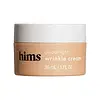What's inside
What's inside
 Key Ingredients
Key Ingredients

 Benefits
Benefits

 Concerns
Concerns

 Ingredients Side-by-side
Ingredients Side-by-side

Water
Skin ConditioningIsopropyl Palmitate
EmollientGlycerin
HumectantCaprylic/Capric Triglyceride
MaskingPropanediol
SolventCetearyl Isononanoate
EmollientButyrospermum Parkii Butter
Skin ConditioningNylon 6/12
AbsorbentOctyldodecanol
EmollientPolyacrylamide
Cetearyl Alcohol
EmollientBeheneth-25
CleansingHydroxyacetophenone
AntioxidantC13-14 Isoparaffin
EmollientParfum
MaskingPEG-100 Stearate
Glyceryl Stearate
EmollientCetearyl Glucoside
EmulsifyingCetyl Palmitate
EmollientLaureth-7
EmulsifyingUrea
BufferingTrehalose
HumectantCaffeine
Skin ConditioningHydrolyzed Trigonella Foenum-Graecum Seed Extract
HumectantXanthan Gum
EmulsifyingCoumarin
PerfumingBenzyl Salicylate
PerfumingPentylene Glycol
Skin ConditioningSerine
MaskingSodium Hyaluronate
HumectantLimonene
PerfumingLinalool
PerfumingPhenoxyethanol
PreservativeCitronellol
PerfumingButylphenyl Methylpropional
PerfumingAlpha-Isomethyl Ionone
PerfumingAdansonia Digitata Pulp Extract
EmollientDisodium Phosphate
BufferingPullulan
Caprylyl Glycol
EmollientAlgin
MaskingWater, Isopropyl Palmitate, Glycerin, Caprylic/Capric Triglyceride, Propanediol, Cetearyl Isononanoate, Butyrospermum Parkii Butter, Nylon 6/12, Octyldodecanol, Polyacrylamide, Cetearyl Alcohol, Beheneth-25, Hydroxyacetophenone, C13-14 Isoparaffin, Parfum, PEG-100 Stearate, Glyceryl Stearate, Cetearyl Glucoside, Cetyl Palmitate, Laureth-7, Urea, Trehalose, Caffeine, Hydrolyzed Trigonella Foenum-Graecum Seed Extract, Xanthan Gum, Coumarin, Benzyl Salicylate, Pentylene Glycol, Serine, Sodium Hyaluronate, Limonene, Linalool, Phenoxyethanol, Citronellol, Butylphenyl Methylpropional, Alpha-Isomethyl Ionone, Adansonia Digitata Pulp Extract, Disodium Phosphate, Pullulan, Caprylyl Glycol, Algin
Water
Skin ConditioningDimethicone
EmollientGlycerin
HumectantDimethicone Crosspolymer
Emulsion StabilisingRetinol
Skin ConditioningRetinyl Propionate
Skin ConditioningNiacinamide
SmoothingTocopheryl Acetate
AntioxidantC13-14 Isoparaffin
EmollientDimethiconol
EmollientPolysorbate 20
EmulsifyingLaureth-4
EmulsifyingLaureth-7
EmulsifyingDisodium EDTA
Polyacrylamide
Acrylates/C10-30 Alkyl Acrylate Crosspolymer
Emulsion StabilisingAminomethyl Propanol
BufferingTitanium Dioxide
Cosmetic ColorantDMDM Hydantoin
PreservativeIodopropynyl Butylcarbamate
PreservativeWater, Dimethicone, Glycerin, Dimethicone Crosspolymer, Retinol, Retinyl Propionate, Niacinamide, Tocopheryl Acetate, C13-14 Isoparaffin, Dimethiconol, Polysorbate 20, Laureth-4, Laureth-7, Disodium EDTA, Polyacrylamide, Acrylates/C10-30 Alkyl Acrylate Crosspolymer, Aminomethyl Propanol, Titanium Dioxide, DMDM Hydantoin, Iodopropynyl Butylcarbamate
Ingredients Explained
These ingredients are found in both products.
Ingredients higher up in an ingredient list are typically present in a larger amount.
This ingredient is also known as "C13-14 Isoalkane".
C13-14 Isoparaffin is created from petroleum-based mineral oils. It is an emollient and helps thicken a product.
As an emollient, it helps keep the skin soft and smooth by creating a barrier on top. This barrier traps moisture in, keeping the skin hydrated.
C13-14 Isoparaffin may not be fungal-acne safe.
Learn more about C13-14 IsoparaffinGlycerin is already naturally found in your skin. It helps moisturize and protect your skin.
A study from 2016 found glycerin to be more effective as a humectant than AHAs and hyaluronic acid.
As a humectant, it helps the skin stay hydrated by pulling moisture to your skin. The low molecular weight of glycerin allows it to pull moisture into the deeper layers of your skin.
Hydrated skin improves your skin barrier; Your skin barrier helps protect against irritants and bacteria.
Glycerin has also been found to have antimicrobial and antiviral properties. Due to these properties, glycerin is often used in wound and burn treatments.
In cosmetics, glycerin is usually derived from plants such as soybean or palm. However, it can also be sourced from animals, such as tallow or animal fat.
This ingredient is organic, colorless, odorless, and non-toxic.
Glycerin is the name for this ingredient in American English. British English uses Glycerol/Glycerine.
Learn more about GlycerinLaureth-7 is created by the ethoxylation of lauryl alcohol using ethylene oxide. Lauryl alcohol is a fatty alcohol with hydrating properties.
This ingredient is an emulsifier and cleansing ingredient. As an emulsifier, it is used to prevent ingredients from separating. It also helps cleanse the skin by gathering dirt, oil, and pollutants to be rinsed away.
Polyacrylamide is a synthetic polymer. It is used to stabilize products and bind ingredients. When hydrated, Polyacrylamide forms a soft gel.
Polyacrylamide is low-toxicity. If source properly, it is deemed safe to use in cosmetics.
It should be noted the precursor to Polyacrylamide is acrylamide. Acrylamide is a carcinogen. Most reputable sources of Polyacrylamide will screen for residual acrylamide to make sure the count is in a safe range. Acrylamide is not able to be absorbed through the skin.
We recommend speaking with a professional if you have concerns.
Learn more about PolyacrylamideWater. It's the most common cosmetic ingredient of all. You'll usually see it at the top of ingredient lists, meaning that it makes up the largest part of the product.
So why is it so popular? Water most often acts as a solvent - this means that it helps dissolve other ingredients into the formulation.
You'll also recognize water as that liquid we all need to stay alive. If you see this, drink a glass of water. Stay hydrated!
Learn more about Water